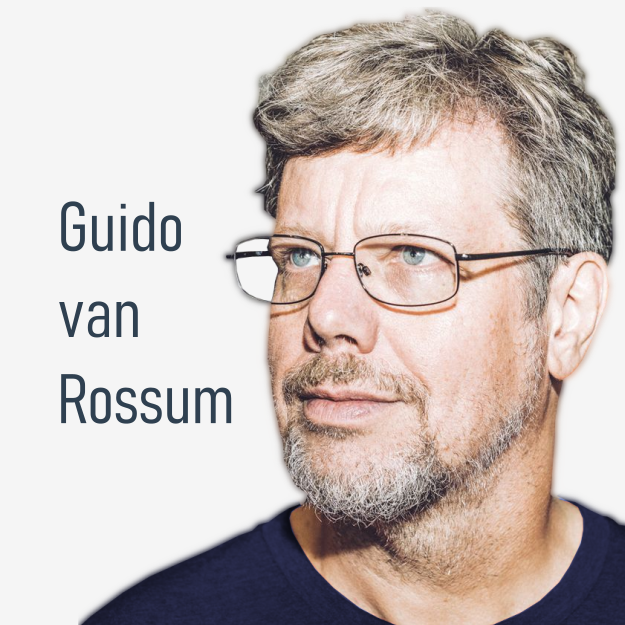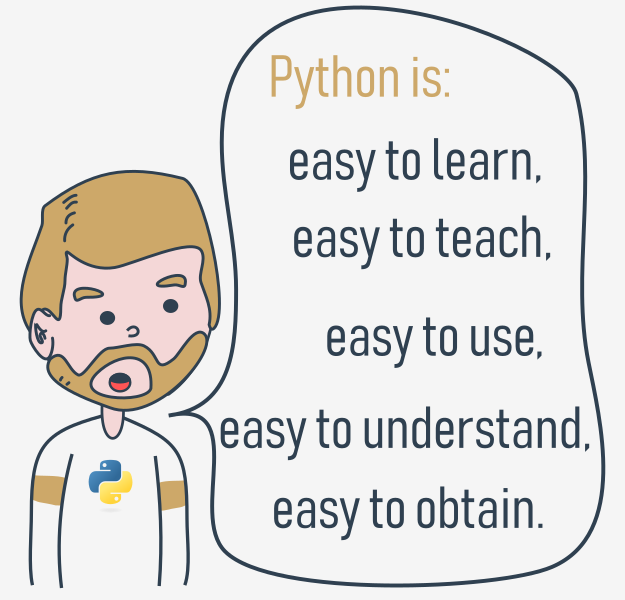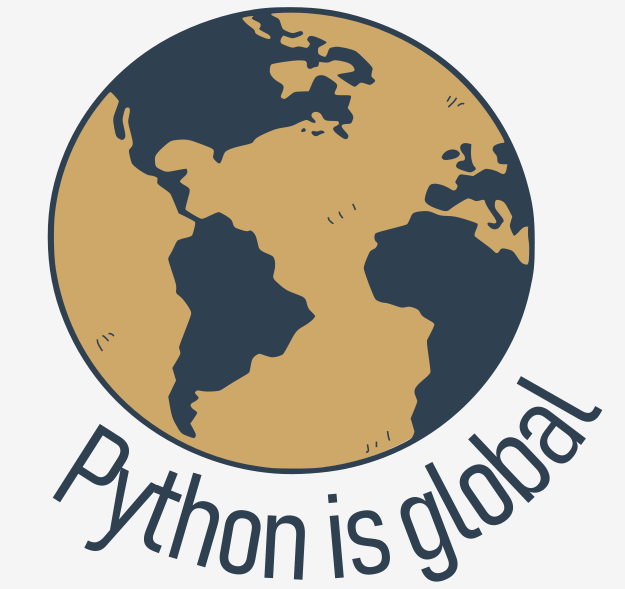פייתון היא שפת תכנות מפורסמת, מתפרשת, מונחית עצמים ורב-שימושית עם תחביר דינמי, המשמשת למגוון רחב של מטרות פיתוח.
למרות שהשם “פייתון” מוכר גם כנחש גדול, השם של שפת התכנות מגיע מסדרת טלוויזיה קומית של ה-BBC בשם “קרקס המעופף של מונטי פייתון”. מייסד השפה, גווידו ואן רוסום, קרא לה על שם התוכנית האהובה עליו, הנחשבת לאחד היסודות המרכזיים של כל מתכנת (השני הוא פיצה).
מי יצר את פייתון?
פייתון היא יצירה של אדם אחד – גווידו ואן רוסום, שנולד ב-1956 בהארלם, הולנד. זה יוצא דופן, שכן רוב שפות התכנות מפותחות על ידי חברות גדולות עם צוותים של מומחים. ואן רוסום יצר את פייתון בשנות ה-80 המאוחרות, והשפה התפתחה בעזרתם של אלפי מתכנתים, בודקים ומשתמשים מכל רחבי העולם.
פייתון היום
הפופולריות של פייתון נובעת מהפשטות שלה ומהקהילה הגדולה שתומכת בה. פייתון משמשת לפיתוח אתרי אינטרנט, מדעי נתונים, בינה מלאכותית ועוד, והיא אחת מהשפות המבוקשות ביותר בשוק העבודה של היום.
פרויקט תכנות כתחביב
פייתון נולדה כסוג של פרויקט תחביב. בדצמבר 1989, גווידו ואן רוסום, מייסד השפה, חיפש פרויקט תכנות שימלא את זמנו במהלך תקופת החגים. בהשראת שפת התכנות ABC והצורך בשפת סקריפטים שמתאימה להאקרים של Unix/C, הוא החל לכתוב מפרש לשפה החדשה והעניק לה את השם “פייתון”, בהשראת התוכנית “קרקס המעופף של מונטי פייתון”.
מטרות פייתון
ב-1999, ואן רוסום הגדיר את מטרותיו עבור פייתון:
- שפה קלה ואינטואיטיבית כמו שפות המתחרות.
- קוד פתוח שכל אחד יכול לתרום לפיתוחו.
- קוד קריא וברור כמו אנגלית פשוטה.
- מתאימה למשימות יומיומיות עם זמני פיתוח קצרים.
כ-20 שנים לאחר מכן, ניתן לראות שהמטרות הללו הושגו במלואן. פייתון נחשבת לאחת משפות התכנות הפופולריות בעולם, והיא נמצאת במקומות הראשונים במדדים כמו PYPL ו-TIOBE.
פייתון היום
פייתון אינה שפה צעירה עוד, אך היא שפה בשלה ואמינה. היא נחשבת לכוכב בהיר בשמי התכנות, וזמן הלמידה שלה הוא השקעה נבונה עבור כל מי שרוצה להשתלב בעולם התכנות.
מה הופך את פייתון למיוחדת?
פייתון היא שפה שמושכת אליה מתכנתים בכל הרמות, ממתחילים ועד מומחים, בזכות מספר יתרונות ייחודיים:
- קלות למידה: פייתון קלה ללמידה, מה שמאפשר להתחיל לתכנת מהר יותר מאשר בשפות אחרות.
- קלות הוראה: היא קלה להוראה, מה שמאפשר למורים להתמקד בטכניקות תכנות כלליות במקום לבלות זמן על תחבירים מסובכים.
- קלות שימוש: ניתן לכתוב קוד במהירות ובפשטות יחסית.
- קלות הבנה: הקוד של פייתון ברור וקל להבנה גם כשמדובר בקוד שנכתב על ידי אחרים.
- ניידות ופשטות פריסה: פייתון היא שפה חינמית, פתוחה ורב-פלטפורמית.
חסרונות פייתון:
- ביצועים: פייתון אינה השפה המהירה ביותר מבחינת ביצועים.
- בדיקות ודיבוג: לעיתים קיים קושי בביצוע בדיקות דיבוג פשוטות.
על אף חסרונותיה, פייתון נותרה בחירה פופולרית הודות ליתרונותיה הרבים, וממשיכה למשוך אליה מפתחים וארגונים רבים ברחבי העולם.
מתחרות ישירות של פייתון
לפייתון יש שתי מתחרות ישירות בעלות תכונות דומות:
- Perl: שפת סקריפטים שנוצרה על ידי לארי וול. היא מסורתית ושמרנית יותר, ומזכירה שפות ישנות שנגזרו מהשפה הקלאסית C.
- Ruby: שפת סקריפטים שנוצרה על ידי יוקיהירו מצומוטו. היא חדשנית יותר ומלאה ברעיונות רעננים לעומת פייתון.
פייתון ממוקמת איפשהו בין שתי השפות הללו, ומשלבת תכונות שמרניות וחדשניות.
איפה רואים את פייתון בפעולה?
פייתון נמצאת בשימוש נרחב בשירותי אינטרנט מורכבים כמו מנועי חיפוש, אחסון בענן, וכלים חברתיים. כלים רבים לפיתוח מיושמים בפייתון, וכך גם יישומים לשימוש יומיומי. מדענים רבים עברו להשתמש בפייתון במקום כלים מסחריים יקרים, ובודקי תוכנה משתמשים בה להליכי בדיקה חוזרים.
למה לא פייתון?
למרות הפופולריות הגדלה של פייתון, ישנם תחומים שבהם היא פחות נפוצה:
- תכנות ברמה נמוכה (“קרוב למתכת”): אם רוצים לכתוב מנהל התקן או מנוע גרפי יעיל מאוד, פייתון אינה הבחירה המתאימה.
- אפליקציות למכשירים ניידים: תחום זה עדיין לא נכבש על ידי פייתון, אך זה עשוי להשתנות בעתיד.
What is Python?
Python is a widely-used, interpreted, object-oriented, and high-level programming language with dynamic semantics, used for general-purpose programming.
And while you may know the python as a large snake, the name of the Python programming language comes from an old BBC television comedy sketch series called Monty Python’s Flying Circus.
At the height of its success, the Monty Python team were performing their sketches to live audiences across the world, including at the Hollywood Bowl.
Since Monty Python is considered one of the two fundamental nutrients to a programmer (the other being pizza), Python’s creator named the language in honor of the TV show.
Who created Python?
One of the amazing features of Python is the fact that it is actually one person’s work. Usually, new programming languages are developed and published by large companies employing lots of professionals, and due to copyright rules, it is very hard to name any of the people involved in the project. Python is an exception.
There are not many languages whose authors are known by name. Python was created by Guido van Rossum, born in 1956 in Haarlem, the Netherlands. Of course, Guido van Rossum did not develop and evolve all the Python components himself.
The speed with which Python has spread around the world is a result of the continuous work of thousands (very often anonymous) programmers, testers, users (many of them aren’t IT specialists) and enthusiasts, but it must be said that the very first idea (the seed from which Python sprouted) came to one head – Guido’s.
A hobby programming project
The circumstances in which Python was created are a bit puzzling. According to Guido van Rossum:
In December 1989, I was looking for a “hobby” programming project that would keep me occupied during the week around Christmas. My office (…) would be closed, but I had a home computer, and not much else on my hands. I decided to write an interpreter for the new scripting language I had been thinking about lately: a descendant of ABC that would appeal to Unix/C hackers. I chose Python as a working title for the project, being in a slightly irreverent mood (and a big fan of Monty Python’s Flying Circus).Guido van Rossum
Python goals
In 1999, Guido van Rossum defined his goals for Python:
- an easy and intuitive language just as powerful as those of the major competitors;
- open source, so anyone can contribute to its development;
- code that is as understandable as plain English;
- suitable for everyday tasks, allowing for short development times.
About 20 years later, it is clear that all these intentions have been fulfilled. Some sources say that Python is the most popular programming language in the world, while others claim it’s the second or the third.
Either way, it still occupies a high rank in the top ten of the PYPL PopularitY of Programming Language and the TIOBE Programming Community Index.
Python isn’t a young language anymore. It is mature and trustworthy. It’s not a one-hit wonder. It’s a bright star in the programming firmament, and time spent learning Python is a very good investment.
What makes Python special?
How does it happen that programmers, young and old, experienced and novice, want to use it? How did it happen that large companies adopted Python and implemented their flagship products using it?
There are many reasons – we’ve listed some of them already, but let’s enumerate them again in a more practical manner:
- it’s easy to learn – the time needed to learn Python is shorter than for many other languages; this means that it’s possible to start the actual programming faster;
- it’s easy to teach – the teaching workload is smaller than that needed by other languages; this means that the teacher can put more emphasis on general (language-independent) programming techniques, not wasting energy on exotic tricks, strange exceptions and incomprehensible rules;
- it’s easy to use for writing new software – it’s often possible to write code faster when using Python;
- it’s easy to understand – it’s also often easier to understand someone else’s code faster if it is written in Python;
- it’s easy to obtain, install and deploy – Python is free, open and multiplatform; not all languages can boast that.
Of course, Python has its drawbacks, too:
- it’s not a speed demon – Python does not deliver exceptional performance;
- in some cases it may be resistant to some simpler testing techniques – this may mean that debugging Python code can be more difficult than with other languages; fortunately, making mistakes is also harder in Python.

It should also be stated that Python is not the only solution of its kind available on the IT market.
It has lots of followers, but there are many who prefer other languages and don’t even consider Python for their projects.
Python rivals?
Python has two direct competitors, with comparable properties and predispositions. These are:
- Perl – a scripting language originally authored by Larry Wall;
- Ruby – a scripting language originally authored by Yukihiro Matsumoto.
The former is more traditional and more conservative than Python, and resembles some of the old languages derived from the classic C programming language.
In contrast, the latter is more innovative and more full of fresh ideas than Python. Python itself lies somewhere between these two creations.
The Internet is full of forums with infinite discussions on the superiority of one of these three over the others, should you wish to learn more about each of them.
Where can we see Python in action?
We see it every day and almost everywhere. It’s used extensively to implement complex Internet services like search engines, cloud storage and tools, social media and so on. Whenever you use any of these services, you are actually very close to Python, although you wouldn’t know it.
Many developing tools are implemented in Python. More and more everyday-use applications are being written in Python. Lots of scientists have abandoned expensive proprietary tools and switched to Python. Lots of IT project testers have started using Python to carry out repeatable test procedures. The list is long.
Why not Python?
Despite Python’s growing popularity, there are still some niches where Python is absent, or is rarely seen:
- low-level programming (sometimes called “close to metal” programming): if you want to implement an extremely effective driver or graphical engine, you wouldn’t use Python;
- applications for mobile devices: although this territory is still waiting to be conquered by Python, it will most likely happen someday.

